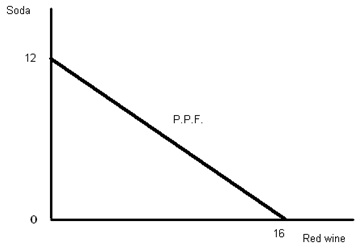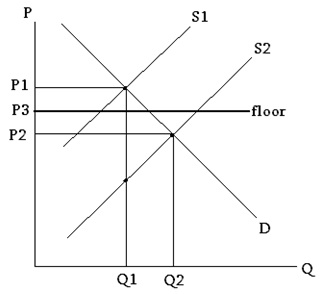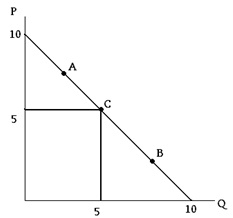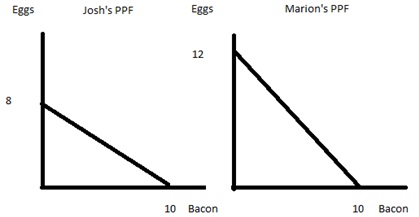Question 1. A government-imposed maximum price at which a good can be sold is called a price ______ .
a. floor
b. ceiling
c. support
d. maximum
e. minimum
Question 2. If you are studying Microeconomics, then you are interested in:
a. The growth in GDP from 2002 to 2003.
b. How firms price goods in particular markets.
c. The study of economy-wide phenomena, including inflation and unemployment.
d. How exchange rates affect trade.
e. How saving affects growth.
Question 3. Here are two points on the PPF of Dane County. (Assume Dane County produces only books and brats.)
Books Brats
Pair 1 1,500 0
Pair 2 0 3,000
Assume that the PPF is a straight line. What is the opportunity cost of 1brat in terms of books?
a. 1,500 books
b. 3,000 books
c. 1/3,000 books
d. 1/2 books
e. 2 books
Question 4. Which of the following would usually be consistent with the Law of Supply if everything else were held constant?
a. An increase in the price of a good increases the quantity demanded of that good.
b. An increase in the price of a good decreases the quantity demanded of that good.
c. A decrease in the price of a good increases the quantity supplied of that good.
d. An increase in the price of a good decreases the quantity supplied of that good.
e. An increase in the price of a good increases the quantity supplied of that good.
Question 5. If demand shifts rightward and supply shifts leftward, then the equilibrium
a. Quantity increases and so does the equilibrium price relative to their initial equilibrium levels.
b. Quantity decreases and the equilibrium price increases relative to their initial equilibrium levels.
c. Quantity changes in an indeterminate way and the equilibrium price decreases relative to their initial equilibrium levels.
d. Quantity changes in an indeterminate way and the equilibrium price increases relative to their initial equilibrium levels.
e. Quantity increases and the equilibrium price changes in an unknown way relative to their initial equilibrium levels.
Question 6. Consider the following PPF for a beverage factory. Which of the following points of production is efficient?

a. 16 red wine, 5 soda
b. 2 red wine, 12 soda
c. 8 red wine, 5 soda
d. 12 red wine, 3 soda
e. 12 red wine, 4 soda
Question 7. Holding everything else constant, the change in price that results from a leftward shift of the supply curve will be greater if:
a. the demand curve is relatively steeper than if the demand curve is relatively flat.
b. the demand curve is relatively flat than if the demand curve is relatively steep.
c. the demand curve is horizontal than if the demand curve is vertical.
d. the demand curve is horizontal than if the demand curve is downward sloping.
e. the demand curve is relatively elastic.
Consider the following table for the following FOUR (4) questions. Assume the PPF’s for Ben and Sol are linear and that they each have the same amount of resources, technology and time.
Time to produce 1 dozen
Apple pies Cream puffs
Ben 4 hrs 2 hrs
Sol 2 hrs 5 hrs
Question 8. How many apple pies or cream puffs can be produced in 20 hours by Ben?
a. 80 dozen apple pies or 40 dozen cream puffs.
b. 40 dozen apple pies or 80 dozen cream puffs.
c. 5 dozen apple pies or 10 dozen cream puffs.
d. 10 dozen apple pies or 5 dozen cream puffs.
e. 10 dozen apple pies or 4 dozen cream puffs.
Question 9. What is the opportunity cost of producing 1 dozen cream puffs for Sol?
a. 2/5 dozen apple pies.
b. 5/2 dozen apple pies.
c. 2 dozen apple pies.
d. 1/2 dozen apple pies.
e. 4/10 dozen apple pies.
Question 10. Which of the following is true?
a. Ben has the comparative advantage in the production of apple pies and absolute advantage in the production of cream puffs.
b. Sol has the comparative advantage in the production of apple pies and absolute advantage in the production of cream puffs.
c. Sol has the absolute and the comparative advantage in the production of apple pies.
d. Ben has the comparative advantage in the production of apple pies.
e. Ben has the absolute and the comparative advantage in the production of apple pies.
Question 11. Given the above information, what is the acceptable range of trading prices in terms of apple pies that Ben and Sol will both accept when trading 2 dozen cream puffs? The acceptable range of trading prices will be between
a. 1/2 apple pie and 2.5 apple pies.
b. 1 apple pie and 5 apple pies.
c. 0.4 apple pies and 4 apple pies.
d. 0.8 apple pies and 8 apple pies.
Question 12. Which of the following is a normative statement?
a. There are about 365 days in a year.
b. Microeconomics is the study of consumer choice, firms, and markets.
c. Macroeconomics is less helpful to consumers than microeconomics.
d. September was very hot this year compared to last year.
e. There are 825 students in lectures one and two of economics 101 during the fall semester of 2013.
Question 13. Holding everything else constant, if an increase in the price of one good leads to an increase in the quantity demanded of another good that is sold, then the two goods are:
a. Substitutes
b. Complements
c. Normal Goods
d. Inferior Goods
e. Unrelated Goods
Question 14. What effect would very bad weather destroying much of the wheat crop have on the market for wheat?
a. A movement along the supply curve to a higher price
b. A movement along the supply curve to a lower price
c. An outward (rightward) shift in the supply curve
d. An inward (leftward) shift in the supply curve
e. The effect on the market is indeterminate
Question 15. If Paul is more productive than David in all areas of production, then
a. neither Paul nor David can benefit from trade.
b. Paul can benefit from trade but David cannot.
c. David can benefit from trade but Paul cannot.
d. David will not have comparative advantage in any of the goods.
e. both Paul and David can benefit from trade.
Use the following information to answer the next TWO (2) questions.
The market for gadgets is described by the following equations where P is the price per gadget, Qd is the quantity of gadgets demanded and Qs is the quantity of gadgets supplied. Notice that I have already found the market equilibrium for you to speed your efforts!
Market demand is P=20-5Qd.
Market supply is P=4+3Qs.
Market equilibrium is therefore (quantity=2, price=10).
Note that you do not have to calculate market equilibrium.
Question 16. Given the above information, find consumer surplus (CS) and producer surplus (PS) in the market for gadgets.
a. CS= $8, PS= $4
b. CS= $12, PS= $6
c. CS= $10, PS= $6
d. CS= $10, PS= $12
e. CS= $6, PS= $10
Question 17. Now suppose the government imposes an excise tax that reduces the equilibrium quantity sold (and consumed) in the market to 1 gadget. Find the deadweight loss created by this excise tax.
a. $3
b. $4
c. $2
d. $5
e. $1
Use the following graph of a market for Good X to answer the next question.

Question 18. Suppose that the government has implemented a price floor in the market for Good X. This price floor is drawn in the graph. Given this price floor, if the supply curve for Good X shifts from S1 to S2 then
a. the market price will fall to P2.
b. a surplus will occur at the price floor of P3.
c. a surplus will occur at the new market price of P2.
d. the market price will stay at P3 due to the price floor.
e. this market will be unaffected by the price floor.
Use the following graph to answer the next question.
The graph depicts the market demand curve for widgets.

Question 19: With demand as is shown in the graph above, at point “A” revenue would _____ if the price increased. At point “B” revenue would _____ if the price increased. At point “C” revenue would ______ if the price increased.
a. increase, increase, increase
b. increase, decrease, increase
c. decrease, increase, decrease
d. decrease, decrease, decrease
e. increase, increase, decrease
Question 20. Peter has the option to work at a library or at a restaurant. He cannot work at both places at the same time. The hourly wage at library is $10, while it is $15 at the restaurant. For Peter, what's the opportunity cost of having a 2-hour-party with his friends?
a. $10
b. $15
c. $20
d. $25
e. $30
Question 21. When there is a surplus amount of the good in a market,
a. there are too many buyers chasing too few goods.
b. there is downward pressure on price.
c. there are too few suppliers providing the good.
d. there is upward pressure on price.
Question 22. The study of economics is based upon the
a. The idea of scarcity and how scarcity implies the need to make choices.
b. Need to know how to manage stock portfolios so that earnings from these portfolios are maximized.
c. The importance of understanding and applying accounting principles.
d. Using unrealistic models to explain scarcity.
Question 23. When I choose to do something, this choice always implies that I am not going to be able to do something else. Thus,
a. tradeoffs occur because of scarcity.
b. every choice has an opportunity cost.
c. the cost of my doing something is the cost of what I must give up in order to do this thing.
d. Answers (a), (b) and (c) are all true answers.
e. Answers (a) and (c) are true answers.
Question 24. Suppose that the following graphs depict the PPFs for Josh and Marion. Josh and Marion both produce eggs and bacon and they both have linear PPFs.

If you construct the joint PPF for Josh and Marion, the coordinate (Bacon, Eggs) for the “kink” point of this joint PPF will be
a. (12, 10)
b. (10, 10)
c. (8. 10)
d. (10, 8)
e. (10, 12)
Now, for some questions from Naked Economics……
Question 25. The Scotsman Thomas Carlyle termed economics the “dismal science” because
a. The study of economics emphasizes that everything has a cost.
b. Economists lack a sense of humor.
c. Economic forecasts are typically gloomy.
d. Economists, despite their years of studying, do not understand how supply and demand work.
e. Answers (a), (c) and (d) are all true answers.
Question 26. Government economists (that is, economists who work in government settings) work in the area of
a. Promoting economic growth.
b. Promoting high employment.
c. Limiting inflation.
d. Answers (a), (b) and (c) are all true answers.
e. Answers (a) and (c) are true answers.
Question 27. There is a famous quote from an economist:
Practical men, who believe themselves to be quite exempt from any intellectual influence, are usually the slaves of some defunct economist. Madmen in authority, who hear voices in the air, are distilling their frenzy from some academic scribbler of a few years back.”
The author of this quote is:
a. BurtonMalkiel (the author of the Foreward in Naked Economics).
b. Charles Wheelan (the author of Naked Economics).
c. Thomas Carlyle (the Scotsman who coined the term “dismal science” for economics).
d. Maynard Keynes (a British civil servant and economist).
e. Adam Smith (the father of economics).
Question 28. Coca-Cola in 1989 went to Berlin and passed out free Cokes. This was
a. An irrational decision since Coca-Cola could have sold the Cokes and earned revenue.
b. A decision that illustrated the degree of sympathy Coca-Cola had for East Germans who longed to topple the Berlin Wall.
c. A savvy business decision to increase the name recognition for Coca-Cola and to begin the process of insuring that Coca-Cola would be a major “player” in a new market.
d. An humanitarian gesture to help the “newly liberated East Germans”.
Question 29. Economists assume that people “act to make themselves as well off as possible”. Given this assumption which of the following statements is true?
a. When Oseola McCarty, a woman who had worked as a laundress in Mississippi, donated $150,000 to the University of Southern Mississippi to endow a scholarship for poor students this illustrated a failure on Ms. McCarty’s part to make “herself as well off as possible” since she could have used this money to purchase a bigger house or a better TV or any number of other items.
b. When Wesley Autrey jumped on the subway tracks in New York City to shield the body of a man who had fallen onto the tracks from an oncoming subway this illustrated a failure on Mr. Autrey’s part to make “himself as well off as possible” since he was placing his life in grave danger with his actions.
c. Altruistic and charitable acts represent a failure on the giver’s part to “act to make themselves as well off as possible”.
d. It is possible to engage in altruistic and charitable acts and not contradict this basic assumption of economics: people who engage in these acts believe that, at the time, they are making “the best possible decision given whatever information is available at that time.” Another way of stating this is that people may have very strong preferences for altruistic and charitable acts and acting on these preferences will result in making “themselves as well off as possible”.
e. Answers (a), (b) and (c) are true answers.
Question 30. Which of the following is least likely to result from rent controls that establish a below equilibrium price for rental housing?
a. A shortage of rental units in the market will develop and this will lead to black market activity in the rental housing market.
b. The quality of existing housing will deteriorate.
c. The future supply of rental housing will increase because the controls bring about excess demand.
d. People will change apartments less often.
Question 31. A market may have a barrier to entry if
a. There is a legal restriction, like a patent or copyright on the product, that limits the entry of potential competing firms into the industry.
b. There is a natural restriction, like a very limited amount of the good, that limits the ability of potential competing firms from entering the industry.
c. There are network effects where the value of a particular good depends upon how many people use the good: for example, in the computer industry new products may find it hard to effectively enter a market if most of the market is already using a rival product.
d. Answers (a), (b) and (c) are all examples of barriers to entry that limit the amount of competition in a market.
e. Answers (a) and (c) are both examples of barriers to entry that limit the amount of competition in a market.
Question 32. Wheelan writes that markets are “amoral….the market is like evolution; it is an extraordinarily powerful force that derives its strength from rewarding the swift, the strong, and the smart. That said, it would be wise to remember that two of the most beautifully adapted species on the planet are _____.”
a. The Wall Street Banker and the ant
b. The rat and the cockroach
c. Politicians and loan sharks
d. The eel and the termite
e. The sloth and the emu
Question 33. Black rhinos in Africa are an endangered species. Which of the following statements is true?
a. Since no one owns the black rhino then no one has the right to kill the black rhino. Once people realize this there will be no endangered species problem.
b. If people owned specific black rhinos it is likely they would protect their property and not overharvest (that is, kill) black rhinos.
c. The black rhino situation is an example of a common resource: black rhinos are so common it is not surprising that people kill them and they have become an endangered species.
d. If governments in Africa were less corrupt, then the problem of potential black rhino extinction would be eliminated.
Question 34. Suppose you own an eco-tourism business that is dependent upon being able to take your customers into the rain forest to see unusual and rare birds. Members of your community however are busy cutting down the rain forest and selling the timber that is cut. This is damaging the habitat of the birds. Given this information, which of the following statements is true?
I. If you decide to engage in a conservation effort, your firm will have higher costs than other firms offering similar eco-tours who do not engage in the conservation effort.
II. Each eco-tourism business has an incentive to free ride on the efforts of other eco-tourism firms to save the habitat.
III. If the price people are willing to pay to see these rare birds is greater than the price received from selling the timber, then local residents may decide to protect the rain forest habitat.
a. Statement I is true.
b. Statement II is true.
c. Statement III is true.
d. Statements I and III are true.
e. Statements I, II and III are true.
Question 35. Which of the following suggestions will reduce the use of carbon-based energy?
a. The government taxes carbon-based energy so that the price per unit of carbon-based energy increases.
b. The government provides subsidies to firms seeking to find new sources of carbon-based energy.
c. The government provides subsidies to consumers so that each unit of carbon-based energy is cheaper for these consumers to buy.
d. Answers (a), (b) and (c) will all result in a reduction in the use of carbon-based energy.
e. Answers (a) and (b) will both result in a reduction in the use of carbon-based energy.
Question 36. The principal-agent problem refers to a situation where
a. The owner or principal’s interests may be very different from the agent or worker’s interest.
b. The principal or idea is executed by the agent or individual in the game.
c. The person you hire may not always pursue your best interest: there is a divergence between what is best for the owner and what is best for the worker.
d. Answers (a), (b) and (c) are all true answers.
e. Answers (a) and (c) are both true answers.
Question 37. Wheelan writes that “capitalism can be brutal”. This statement is
a. Just another way to remind us of Joseph Schumpeter’s term “creative destruction”.
b. A reminder that a market will have losers and winners: firms that provide goods that people want will be successful and firms that fail to provide goods that people want will fail.
c. A reminder that when a firm closes it may be years before the people who lost jobs recover.
d. Answers (a), (b) and (c) are all true statements.
Question 38. Economists favor taxes that “are broad, simple, and fair.” To meet this criteria,
a. A tax should be easy to collect and easy for the public to understand.
b. The tax paid by individuals should be the same if the individuals have similar means and circumstances.
c. The tax should be a large tax paid by a small group of people.
d. Answers (a), (b) and (c) are all true statements.
e. Answers (a) and (b) are both true statements.
Question 39. An externality
a. May occur when the private costs of a behavior are not the same as the social costs of that behavior.
b. Will not be corrected by the market without some type of government intervention.
c. Can be corrected through legal activity to limit the externality generating activity.
d. Answers (a), (b) and (c) are all true statements.
Question 40. All of the following are ways to deal with externalities EXCEPT
a. Government can regulate the activity that generates the externality.
b. Government can either tax the activity that generates a negative externality or subsidize the activity that generates a positive externality.
c. Government can ignore the externality and wait for the market to correct the problem.
d. Moral sanctions can be embraced by society in order to reduce some types of externalities: for example, the adage to “do unto others as you would have them do to you” may be an effective way to reduce some externalities.